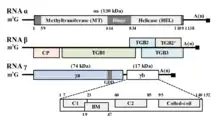Hordeivirus
Hordeivirus is a genus of viruses, in the family Virgaviridae.[1] Plants serve as natural hosts. There are currently four species in this genus including the type species Barley stripe mosaic virus.[1][2][3][4]
| Hordeivirus | |
|---|---|
| Virus classification | |
| (unranked): | Virus |
| Realm: | Riboviria |
| Kingdom: | Orthornavirae |
| Phylum: | Kitrinoviricota |
| Class: | Alsuviricetes |
| Order: | Martellivirales |
| Family: | Virgaviridae |
| Genus: | Hordeivirus |
| Type species | |
| Barley stripe mosaic virus | |
Taxonomy
Group: ssRNA(+)
- Family: Virgaviridae
- Genus: Hordeivirus
- Anthoxanthum latent blanching virus
- Barley stripe mosaic virus
- Lychnis ringspot virus
- Poa semilatent virus
Structure

Viruses in the genus Hordeivirus are non-enveloped, with rod-shaped geometries. The diameter is around 20-25 nm, with a length of 20-25 nm. Genomes are linear and segmented, tripartite or quadripartite, around 3.3kb in length.[1][2]
| Genus | Structure | Symmetry | Capsid | Genomic arrangement | Genomic segmentation |
|---|---|---|---|---|---|
| Hordeivirus | Rod-shaped | Helical | Non-enveloped | Linear | Segmented |
Life cycle
Viral replication is cytoplasmic, and is lysogenic. Entry into the host cell is achieved by penetration into the host cell. Replication follows the positive stranded RNA virus replication model. Positive stranded RNA virus transcription is the method of transcription. Translation takes place by leaky scanning. The virus exits the host cell by tripartite non-tubule guided viral movement. Plants serve as the natural host. Transmission routes are seed borne.[1][2]
| Genus | Host details | Tissue tropism | Entry details | Release details | Replication site | Assembly site | Transmission |
|---|---|---|---|---|---|---|---|
| Hordeivirus | Plants | None | Unknown | Viral movement | Cytoplasm | Cytoplasm | Mechanical: contact; seed |
References
- "ICTV Report Virgaviridae".
- "Viral Zone". ExPASy. Retrieved 15 June 2015.
- ICTV. "Virus Taxonomy: 2014 Release". Retrieved 15 June 2015.
- Bragg, J.N., Solovyev, A.G., Morozov, S. Yu, Atabekov, J.G. Jackson, A.O. Horeivirus (2006). ICTVdB - The Universal Virus Database, version 4. Büchen-Osmond, C (Ed), Columbia University, New York, USA.